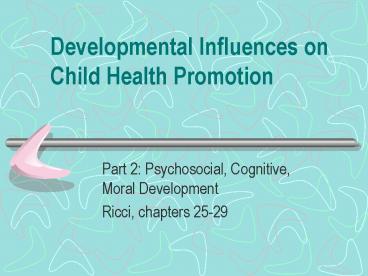Developmental Influences on Child Health Promotion PowerPoint PPT Presentation
1 / 17
Title: Developmental Influences on Child Health Promotion
1
Developmental Influences on Child Health Promotion
- Part 2 Psychosocial, Cognitive, Moral
Development - Ricci, chapters 25-29
2
GD Theories
- Piagetcognitivelearning to think, reason, make
judgments - Eriksonpsychosocialpersonality development
- Kohlbergmoraldevelopment of a sense of right
and wrong
3
Piaget
- Sensorimotor phaselearning thru senses and motor
skills. Object permanence is major task. - Preoperational phaseegocentrisminability to see
others point of view. Concrete thinking based
on what is observed. - Concrete operationsmostly concrete thinking with
beginnings of abstract thought. Conservation and
reversibility are major concepts - Formal operationsabstract thinking. Develops a
workable philosophy of life.
4
Erikson
- Trust vs. mistrust (0-1). Relationship to primary
caregiver is essential to establishing trust. - Autonomy vs. shame doubt (1-3). Need to do
things for self. When stopped or made to feel
wrong about it, feel shame and doubt. - Initiative vs. guilt (3-6). Creating and starting
things on ones own. Egocentrism causes guilt. - Industry vs. inferiority (6-12). Need to feel
worthwhile and important is crucial. Comparison
to peers creates feelings of inferiority. - Identity vs. role confusion (12-18). Striving for
a sense of self and belonging and finding a
direction are important. Demands on self and from
others can create confusion.
5
Kohlberg
- Preconventional leveldoing what is right to
avoid punishment or because it is in his own best
interests and is fair - Conventional leveltries to live up to others
expectations what is right is whatever is
societys rules - Postconventional leveldoing good accd to what
is best for greatest universal moral
principles of justice, equal rights, and respect
for human dignity
6
Developmental TasksInfant
- Trust
- Begins separateness
- Develops and desires affection
- Preverbal communication of needs
- Learns language
- Fine and gross motor skills
- Explores environment
- Develops object permanence
7
Toddler
- Egocentric
- Begins socially acceptable behavior
- Separateness
- Increased verbal communication skills
- Tolerates delayed gratification
- Controls body functions
- Begins self-care
8
Preschooler
- Sense of initiative
- Increased language skills
- Behaves in socially acceptable ways
- Develops conscience
- Identifies sex roles
- Develops readiness for school
9
School Age
- Active and cooperative member of group
- Learns rules/norms of society adapts to moral
standards - Increased psychomotor and cognitive skills
- Masters time, conservation, and reversibility
- Masters oral and written communication
- Wins approval from adults and peers
- Builds a sense of industry and self-concept
- Gives affection without expecting anything
10
Adolescence
- Develops group and self identity
- Gains independence from parents
- Develops value system
- Develops academic vocational skills
- Develops analytical skills
- Adjusts to rapid physical sexual changes
- Develops sexual identity
- Develops multicultural skills
- Considers and chooses career
11
Role of Play in Development
- Universal language of children
- Provides socialization
- Stimulates developmentphysical, emotional, and
cognitive, moral - Develops creativity
- Provides outlet for fears
- Helps develop self-awareness
12
Social Character of Play
- Solitary or onlooker playplays by self or enjoys
watching others (infancy) - Parallel playplays with same toy, but with no
interaction (toddler) - Associativeplays same thing as others in group,
but no group plan or goal (preschool) - Cooperativetogether with others, play is
organized with group goal (school-age)
13
Developmental Assessment
- To identify children whose developmental level is
below normal for chronologic age and who
therefore require further investigation - Remember, most are only screening tools, not
diagnostic.
14
Risk Factors p. 1055
- LBW, prematurity
- CNS problems or neuromuscular issues
- Hyperbilirubinemia/kernicterus
- Congenital malformations (syndromes)
- Chronic OM
- Inborn error of metabolism (PKU)
- Perinatal infections
- Parental issuesdrugs, ETOH, low income, mental
illness, etc
15
Warning Signs (p. 1056)
- No response to stimuli, does not interact with
others - No babbling
- Persistent primitive reflexes
- Abnormal posturinghead lag, fisting, arching,
tiptoeing - Failure to achieve gross and fine motor
milestones - Failure to achieve language milestones echolalia
- Extreme aggressiveness, fearfulness, sadness
- Easily distracted, cant concentrate
- Rarely engages in fantasy play
- Failure to achieve personal-social skills or
self-help activities
16
Denver Developmental Screening Test II
- AKA Denver II or DDST
- Widely used, standardized measures
- Tests personal-social, language, fine, gross
motor skills - Examiners must be specifically trained and
certified in use of the tools - Have to have a kit with specific items to
administer the test and follow instructions in
the manual to ensure validity of the test.
17
Interpretation of Denver
- Dont use the word test with a parent, but tell
them it is a guide - If child fails skill, reevaluate in 1-4 weeks
- If still problems, do not freak parents out
remind them this is screening only - Refer to pediatrician or developmental testing
center for further evaluation

